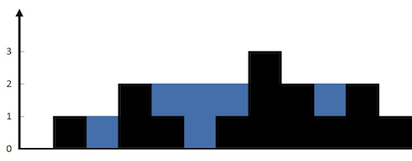Trapping Rain Water
Given n non-negative integers representing an elevation map where the width of each bar is 1, compute how much water it is able to trap after raining.
For example,
Given [0,1,0,2,1,0,1,3,2,1,2,1], return 6.

The above elevation map is represented by array [0,1,0,2,1,0,1,3,2,1,2,1]. In this case, 6 units of rain water (blue section) are being trapped. Thanks Marcos for contributing this image!
找到最长的木板所在的位置,分别从左侧和右侧向其逼近。
在左侧逼近过程中:
如果一个木板的长度小于已经遍历的最大长度max,即max>该木板<maxIdx,所以在该木板位置能存max - 该木板长度的水量(左右两侧各有一个木板长于它)。
如果一个木板的长度大于已经遍历的最大长度max,即max<该木板<maxIdx,所以在该木板位置不能存水(因为左右两侧只有一个木板(maxIdx)长于它)。更新max值。
右侧逼近过程与左侧相似。
1 class Solution { 2 public: 3 int trap(int A[], int n) { 4 5 if(n==0) return 0; 6 7 int i; 8 int maxIndex=0; 9 int Amax=A[0]; 10 11 for(i=1;i<n;i++) 12 { 13 if(Amax<A[i]) 14 { 15 Amax=A[i]; 16 maxIndex=i; 17 } 18 } 19 20 int curMax=A[0]; 21 int totalWater=0; 22 23 for(i=1;i<maxIndex;i++) 24 { 25 if(A[i]<curMax) totalWater+=curMax-A[i]; 26 else curMax=A[i]; 27 } 28 29 curMax=A[n-1]; 30 for(i=n-2;i>maxIndex;i--) 31 { 32 if(A[i]<curMax) totalWater+=curMax-A[i]; 33 else curMax=A[i]; 34 } 35 36 return totalWater; 37 } 38 };